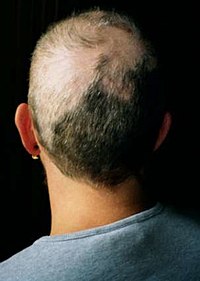
Photo from wikipedia
OBJECTIVES This study evaluated the treatment efficacy of habit reversal training (HRT) relative to treatment as usual (TAU) for children and adolescents aged 7-17 years with a primary diagnosis of… Click to show full abstract
OBJECTIVES This study evaluated the treatment efficacy of habit reversal training (HRT) relative to treatment as usual (TAU) for children and adolescents aged 7-17 years with a primary diagnosis of trichotillomania (TTM). METHOD An initial assessment consisting of semistructured interviews and rating scales was conducted. Participants (N = 40, 85% female) meeting diagnostic criteria for TTM were randomized to either 8 weekly sessions of HRT by trained therapists or 8 weeks of TAU. One week after the final HRT session or final TAU week, patients completed a posttreatment assessment, followed by 1- and 3-month follow-up assessments. All assessments were conducted by a trained rater who was blinded to treatment condition. RESULTS The group by time analysis of variance yielded a significant interaction on the National Institute of Mental Health-Trichotillomania Severity Scale Total Score (F1,38 = 16.47, p < 0.001, η2p = 0.30). The mean score decreased from 12.67 ± 4.60 at baseline to 5.62 ± 4.38 at posttreatment in the HRT group (t20 = 5.99, p < 0.001, d = 1.31), whereas the TAU group changed from 10.42 ± 4.35 to 9.32 ± 4.11 (t18 = 1.34, p = 0.20, d = 0.31). The Massachusetts General Hospital-Hair Pulling Scale Total Score decreased from 15.14 ± 3.86 at baseline to 7.14 ± 5.54 at posttreatment in the HRT group (t20 = 6.16, p < 0.001, d = 1.34); the TAU group changed from 14.16 ± 4.51 to 12.26 ± 4.34 (t18 = 1.50, p = 0.15, d = 0.34). On the Clinical Global Impressions-Improvement, 16/21 participants (76%) were rated as treatment responders in the HRT group versus 4/19 (21%) in the TAU group (χ2 = 12.13, p < 0.001, V = 0.55). At 1-month follow-up, 10-12 treatment responders who completed the assessment maintained improvement. At 3-month follow-up, six of eight maintained improvement. CONCLUSIONS HRT can be an effective treatment for TTM in youth.
Journal Title: Journal of child and adolescent psychopharmacology
Year Published: 2017
Link to full text (if available)
Share on Social Media: Sign Up to like & get
recommendations!